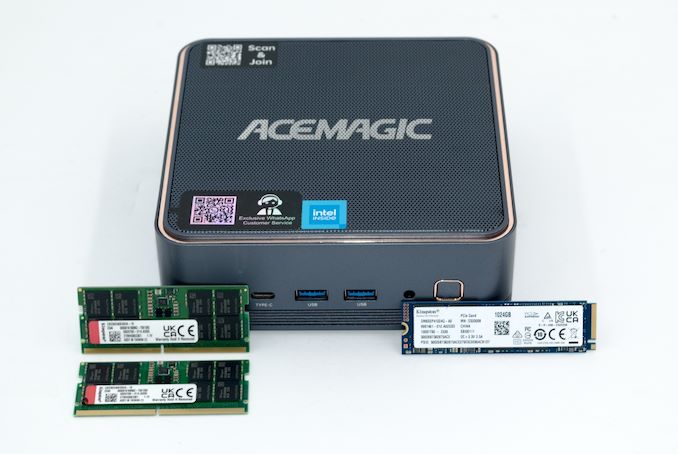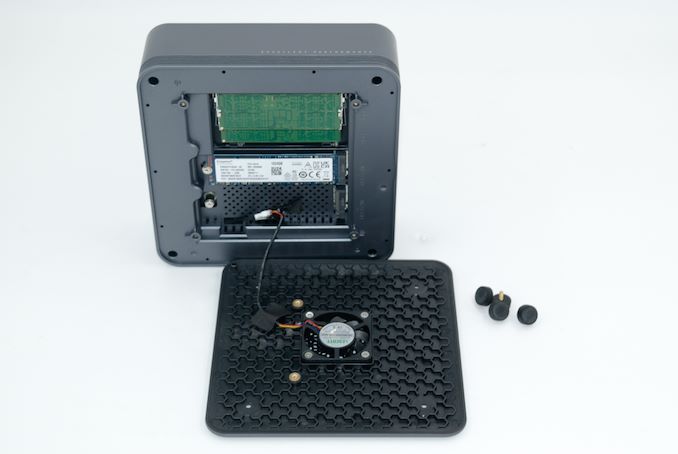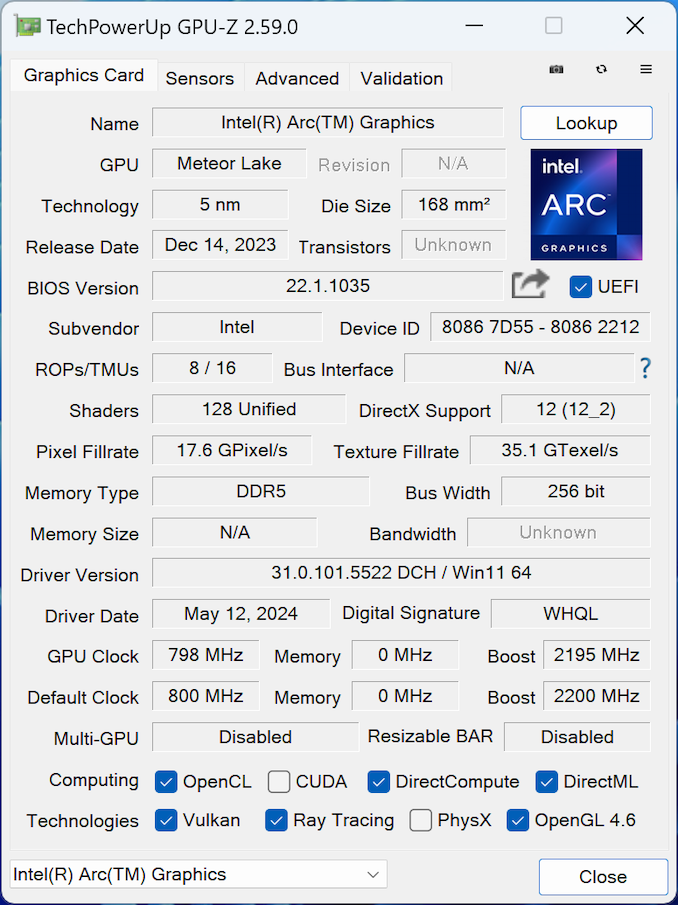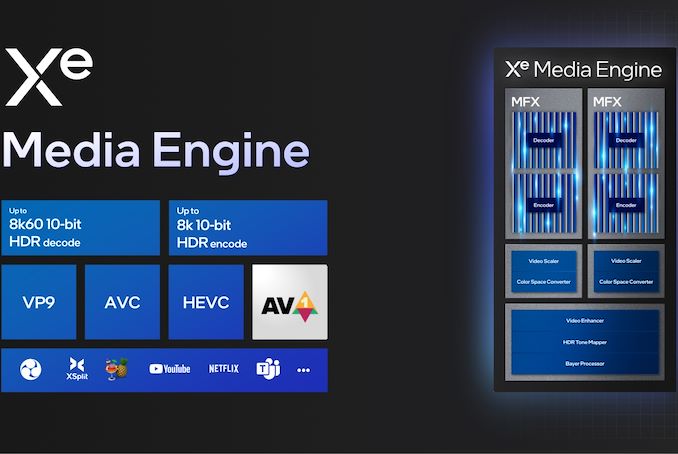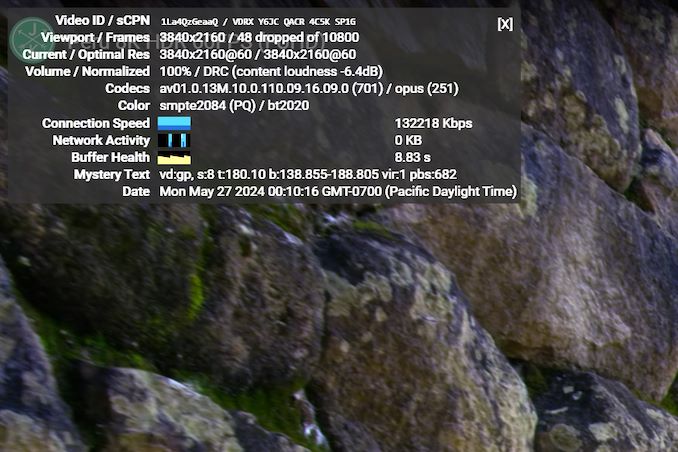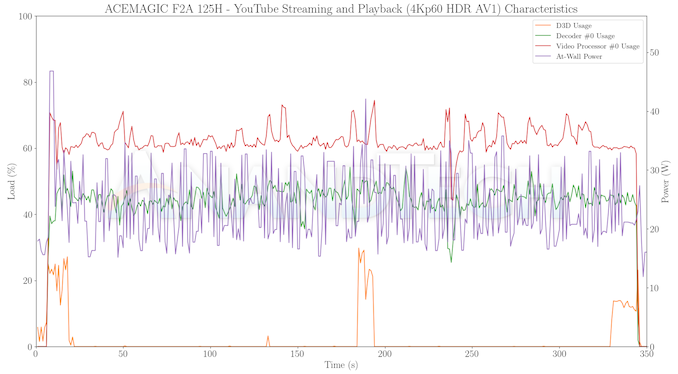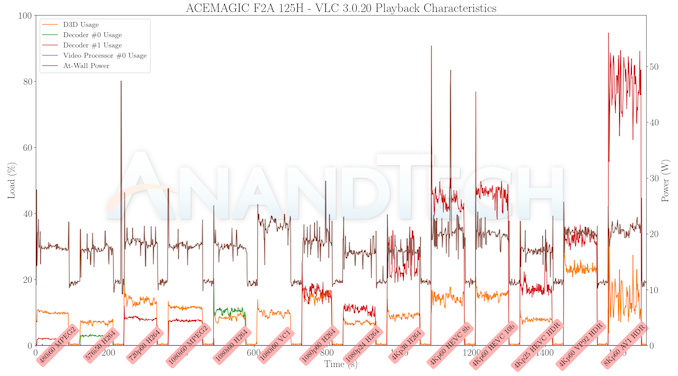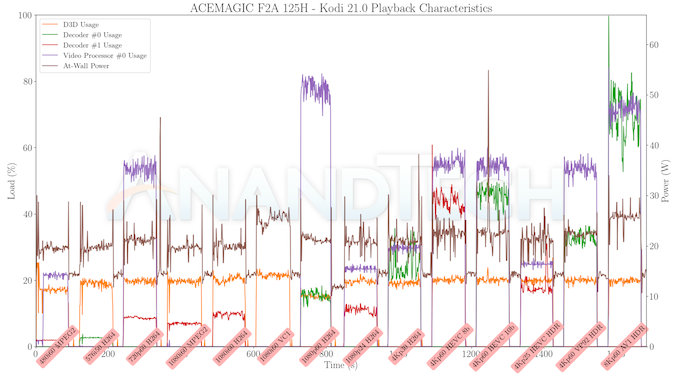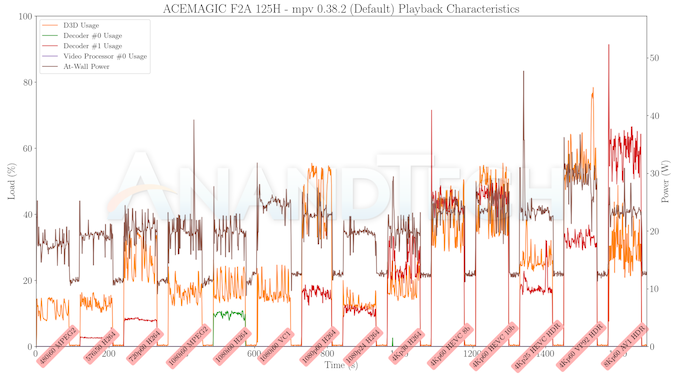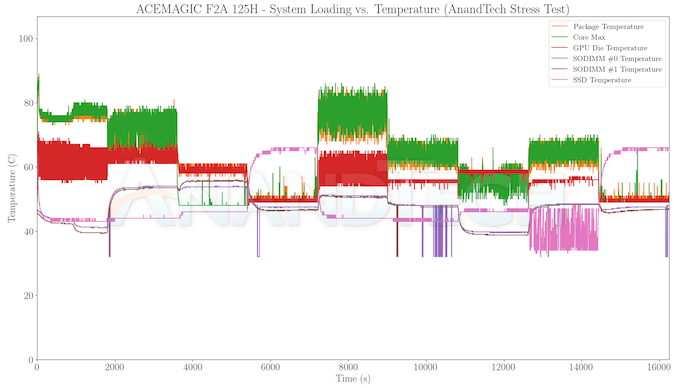
Original Link: https://www.anandtech.com/show/21416/acemagic-f2a-meteor-lakeh-sff-pc-review
ACEMAGIC F2A 125H SFF PC Review: Mid-Range Meteor Lake at 65W
by Ganesh T S on August 26, 2024 8:00 AM EST- Posted in
- Systems
- Intel
- SFF
- Mini-PC
- Meteor Lake
- AceMagician

Compact computing systems have gained significant market share over the last decade. Improvements in the performance per watt metric of processors have enabled the replacement of bulky desktop PCs by ultra-compact form-factor (UCFF) and small form-factor (SFF) machines. The Meteor Lake series of processors is the latest Intel offering to service this market. They have had a drawn-out launch since initial information was officially made available in September 2023. The tile-based chiplet configuration held together with Foveros packaging represented a major shift in Intel's approach to the consumer market, with notebook platforms being the primary focus. That has not prevented multiple vendors from introducing SFF / UCFF desktop systems using the Meteor Lake Ultra H-series (MTL-H) processors.
ACEMAGIC sampled us their F2A 125H offering around the time we were completing the evaluation of the ASRock Industrial NUC BOX-155H and the ASUS NUC14RVHv7 UCFF systems. The F2A is has a larger physical footprint compared to either of those systems. This allows for a better thermal solution, enabling the internal processor (Core Ultra 5 125H) to be operated with a sustained power limit (PL1) setting of 65W.
This review takes a detailed look at the features and performance profile of the ACEMAGIC F2A 125H. The analysis also provides some insights into the optimal operating power setting for the MTL-H processors.
Introduction and Product Impressions
The last decade has seen significant strides in processor performance as well as power efficiency. Coupled with advancements in thermal solutions, we have seen compact systems with low-power SoCs becoming capable of replacing bulky desktops for many use-cases. This trend gained mainstream attention with Intel's introduction of the ultra-compact form-factor (4in. x 4in.) NUC in the early 2010s.
In recent years, we have seen a steady progression in the power envelop of the processors getting integrated into such systems. The first generation NUCs had processors with a TDP between 6W and 15W. In the late 2010s, 28W processors formed the flagship lineups. With Tiger Lake, Intel introduced the Panther Canyon NUCs with a 40W limit. 65W has proved almost impossible to cool within UCFF constraints - and that has prompted ASUS to introduce the NUC14 Pro+ with a slightly larger footprint. ACEMAGIC's F2A also operates the processor at 65W albeit with a footprint even larger than that of the NUC14 Pro+.
The F2A system comes in at 147 mm x 147 mm x 52 mm (compared to the 144 mm x 112 mm x 41 mm of the NUC14 Pro+ and 117 mm x 112 mm x 54 mm of the tall 4"x4" NUC14 Pro). The promotion for the PC's AI features is heavy in the external package as well as the marketing collateral. The package contents include a 120W (19V @ 6.3A) power adapter, a geo-specific power cord, a HDMI cable, an user manual, and a mounting plate with screws in addition to the main unit.
ACEMAGIC sells the F2A as a ready-to-use system with 32 GB of DDR5-5600 SODIMMs and a 1 TB PCIe 4.0 x4 NVMe SSD. Windows 11 Home is pre-installed on the system. We always advise users of systems from vendors such as ACEMAGIC to wipe the drive and install their own copy of the OS after getting the key from the original installation.
Our sample was equipped with Kingston SODIMMs and a Kingston Design-In OEM SSD (BiCS5 TLC NAND behind a Silicon Motion SM2267XT DRAM-less controller).
Access to the SSD and SODIMM slots is obtained by removing four screws from the underside of the system. We were pleasantly surprised to find a fan attached to the underside. Active cooling for the SSD and SODIMMs ought to result in good thermal performance, and that is one of the aspects evaluated further down in this review.
The full specifications of the review sample are provided in the table below.
| ACEMAGIC F2A 125H Specifications (as tested) |
|
| Processor | Intel Core Ultra 5 125H Meteor Lake-H 4P + 8E + 2LPE / 18T, up to 4.5 GHz (P) up to 3.6 GHz (E) up to 2.5 GHz (LPE) Intel 4 (CPU) / TSMC N5 (iGPU), 18MB L2, Min / Max / Base TDP: 20W / 115W / 28W PL1 = 65W, PL2 = 90W |
| Memory | Kingston CBD56S46BS8HA-16 DDR5-5600 SODIMMs 46-45-45-90 @ 5600 MHz 2x16 GB |
| Graphics | Intel Arc Graphics (7 Xe-cores @ up to 2.2 GHz) |
| Disk Drive(s) | Kingston Design-In SSD OM8SEP41024Q-A0 (1 TB; M.2 2280 PCIe 4.0 x4 NVMe;) (Kioxia BiCS5 (112L) 3D TLC; Silicon Motion SM2267XT DRAM-less SSD Controller) |
| Networking | 1x 2.5 GbE RJ-45 (Realtek RTL8125) Intel Wi-Fi 7 BE200 (2x2 802.11be - 5.8 Gbps) |
| Audio | Conexant SN6140 (3.5mm Audio Jack in Front) Digital Audio with Bitstreaming Support over HDMI and Display Port (Type-C) |
| Video | 2x HDMI 2.0 (Rear) 1x DisplayPort 1.4 over Type-C Alt-Mode (Front / USB 3.2 Gen 2) |
| Miscellaneous I/O Ports | 2x USB 3.2 Gen 1 Type-A (Front) 1x USB 3.2 Gen 2 Type-C (Front, with DP Alt Mode) 2x USB 3.2 Gen 1 Type-A (Rear) |
| Operating System | Windows 11 Enterprise (22631.3593) |
| Pricing | $699 (Amazon) $569 (ACEMAGIC Storefront) (as configured, with Win 11 Home) |
| Full Specifications | ACEMAGIC F2A 125H Specifications |
In the next section, we take a look at the system setup and follow it up with a detailed platform analysis.
Setup Notes and Platform Analysis
Our review sample of the ACEMAGIC F2A 125H came with all the necessary components pre-installed, along with the OS. We opted to wipe the drive and load up our own copy of Windows 11 to start our evaluation process. Prior to that, we took some time to look into the BIOS interface. ACEMAGIC ships the system with plenty of BIOS options left in a configurable state for the end user., as shown in the video below.
The diagram below presents the overall high-speed I/O distribution.
This brings us to one of the biggest weaknesses of the F2A - the number of ports and their variety is abysmal. We get four 5 Gbps Type-A ports (two in the front and two in the rear), and a 10 Gbps Type-C port in the front. While the networking side is commendable - a 2.5 Gbps RJ45 port and a Wi-Fi 7 (802.11be) WLAN card with Bluetooth 5.4 support - the absence of Thunderbolt / USB4 in a $500+ system is inexcusable.
Other than the USB ports, the high-speed I/O lanes are distributed as below:
- PCIe 4.0 x1 #8: Realtek RTL8125 Gaming 2.5GbE Family Ethernet Controller
- PCIe 4.0 x4 #9: Intel Wi-Fi 7 BE200 320MHz #4 Wireless Network Adapter
- PCIe 4.0 x4 #10: Kingston NVMe SSD Controller
One of the interesting things to note here is that the audio jack is enabled by a Conexant SN6140 audio codec, and not the usual Realtek ALC ones.
In today's review, we compare the ACEMAGIC F2A 125H with a host of other systems based on processors with TDPs ranging from 20W to 65W. The systems do not target the same market segments, but a few key aspects lie in common, making the comparisons relevant.
| Comparative PC Configurations | ||
| Aspect | ACEMAGIC F2A 125H | |
| CPU | Intel Core Ultra 5 125H Meteor Lake-H 4P + 8E + 2LPE / 18T, up to 4.5 GHz (P) up to 3.6 GHz (E) up to 2.5 GHz (LPE) Intel 4 (CPU) / TSMC N5 (iGPU), 18MB L2, Min / Max / Base TDP: 20W / 115W / 28W PL1 = 65W, PL2 = 90W |
Intel Core Ultra 5 125H Meteor Lake-H 4P + 8E + 2LPE / 18T, up to 4.5 GHz (P) up to 3.6 GHz (E) up to 2.5 GHz (LPE) Intel 4 (CPU) / TSMC N5 (iGPU), 18MB L2, Min / Max / Base TDP: 20W / 115W / 28W PL1 = 65W, PL2 = 90W |
| GPU | Intel Arc Graphics (7 Xe-cores @ up to 2.2 GHz) |
Intel Arc Graphics (7 Xe-cores @ up to 2.2 GHz) |
| RAM | Kingston CBD56S46BS8HA-16 DDR5-5600 SODIMMs 46-45-45-90 @ 5600 MHz 2x16 GB |
Kingston CBD56S46BS8HA-16 DDR5-5600 SODIMMs 46-45-45-90 @ 5600 MHz 2x16 GB |
| Storage | Kingston Design-In SSD OM8SEP41024Q-A0 (1 TB; M.2 2280 PCIe 4.0 x4 NVMe;) (Kioxia BiCS5 (112L) 3D TLC; Silicon Motion SM2267XT DRAM-less SSD Controller) |
Kingston Design-In SSD OM8SEP41024Q-A0 (1 TB; M.2 2280 PCIe 4.0 x4 NVMe;) (Kioxia BiCS5 (112L) 3D TLC; Silicon Motion SM2267XT DRAM-less SSD Controller) |
| Wi-Fi | 1x 2.5 GbE RJ-45 (Realtek RTL8125) Intel Wi-Fi 7 BE200 (2x2 802.11be - 5.8 Gbps) |
1x 2.5 GbE RJ-45 (Realtek RTL8125) Intel Wi-Fi 7 BE200 (2x2 802.11be - 5.8 Gbps) |
| Price (in USD, when built) | $699 (Amazon) $569 (ACEMAGIC Storefront) (as configured, with Win 11 Home) |
$699 (Amazon) $569 (ACEMAGIC Storefront) (as configured, with Win 11 Home) |
The next few sections will deal with comparative benchmarks for the above systems.
System Performance: UL and BAPCo Benchmarks
Our 2022 Q4 update to the test suite for Windows 11-based systems carries over some of the standard benchmarks we have been using over the last several years. While UL's PCMark makes the list, we have opted to temporarily suspend reporting of BAPCo's SYSmark scores (pending fixture of the energy consumption aspect). Instead, BAPCO's CrossMark multi-platform benchmarking tool has been added to the set along with UL's Procyon suite. While CrossMark employs idle time compression and processes all workloads in an opaque manner, UL's Procyon processes real-world workloads with user interactions (like BAPCo's SYSmark). We have augmented the UL Procyon suite benchmark with our own custom energy measurement setup.
UL PCMark 10
UL's PCMark 10 evaluates computing systems for various usage scenarios (generic / essential tasks such as web browsing and starting up applications, productivity tasks such as editing spreadsheets and documents, gaming, and digital content creation). We benchmarked select PCs with the PCMark 10 Extended profile and recorded the scores for various scenarios. These scores are heavily influenced by the CPU and GPU in the system, though the RAM and storage device also play a part. The power plan was set to Balanced for all the PCs while processing the PCMark 10 benchmark. The scores for each contributing component / use-case environment are also graphed below.
| UL PCMark 10 - Performance Scores | |||
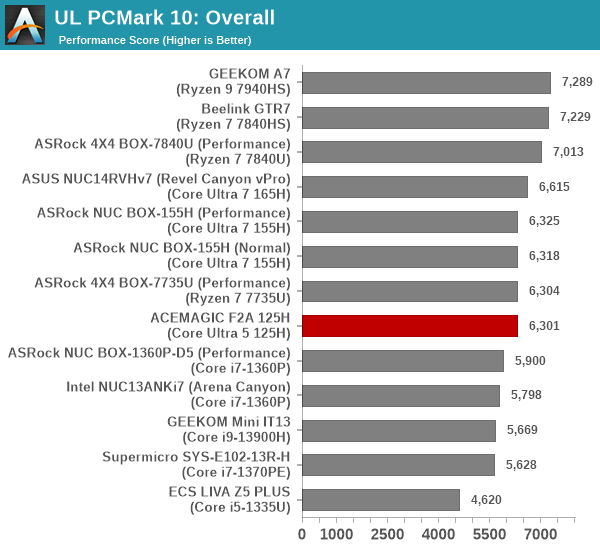
Almost all of the compared systems use either the Intel Core i7-class processor or the AMD Ryzen 7-class ones. The ECS LIVA Z5 PLUS is the only one with a Core i5, albeit with a U-series member at a much lower power point (20W). The Core Ultra 5 125H at 65W manages to put in a good enough showing to land up in the middle of the pack across all components.
UL Procyon v2.1.544
PCMark 10 utilizes open-source software such as Libre Office and GIMP to evaluate system performance. However, many of their professional benchmark customers have been requesting evaluation with commonly-used commercial software such as Microsoft Office and Adobe applications. In order to serve their needs, UL introduced the Procyon benchmark in late 2020. There are five benchmark categories currently - Office Productivity, AI Inference, Battery Life, Photo Editing, and Video Editing. AI Inference benchmarks are available only for Android devices, while the battery life benchmark is applicable to Windows devices such as notebooks and tablets. We presents results from our processing of the other three benchmarks.
| UL Procyon - Office Productivity Scores | |||
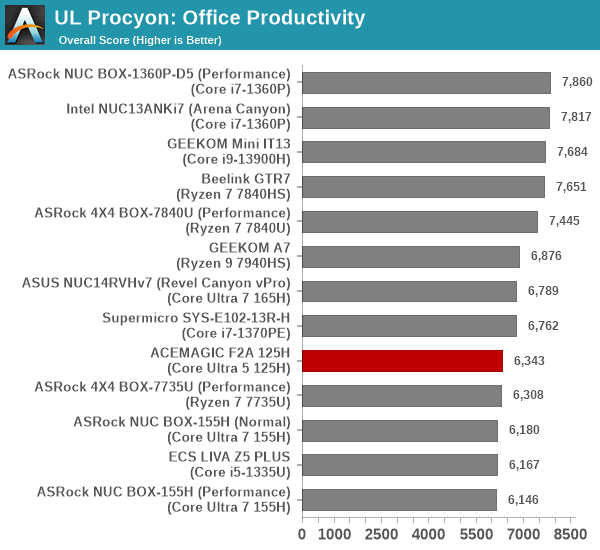
The Excel workload appears to be a weak point for Meteor Lake systems in general, with the F2A being at the bottom of the pack. However, its performance with a 65W configuration in the other components helps it climb into the middle of the pack for the overall score.

From an energy consumption viewpoint, the sustained 65W setting along with a reduction in the number of fast cores (compared to the Ultra 7 155H in the other MTL-based systems) mean that the F2A ends up consuming a lot more energy for the office workload compared to the NUC14 Pro or the ASRock Industrial NUC BOX-155H in its default configuration. In fact, the F2A ties for the second worst energy consumption number in this case.
Moving on to the evaluation of Adobe Photoshop and Adobe Lightroom, we find the F2A 125H in the bottom half - reflecting the cutting down in the number of high-performance cores due to its Ultra 5 / i5-class nature.
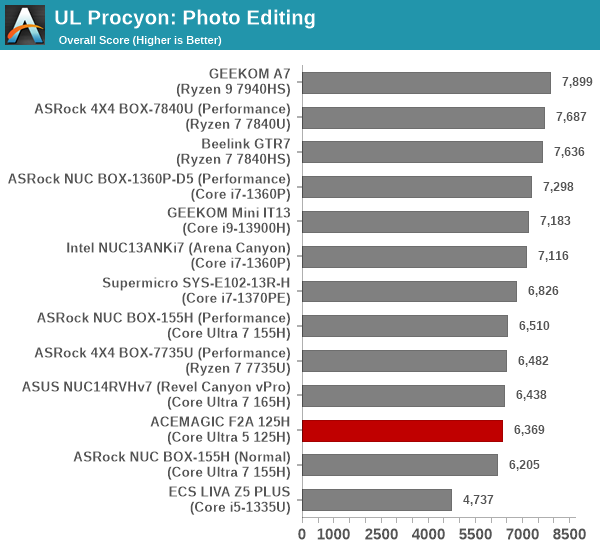
Despite the longer time taken to complete the benchmark, the power consumption throughout the processing is lower compared to systems like the NUC14 Pro. This results in a slight advantage in the energy numbers, allowing the F2A 125H to shift towards the center of the pack.
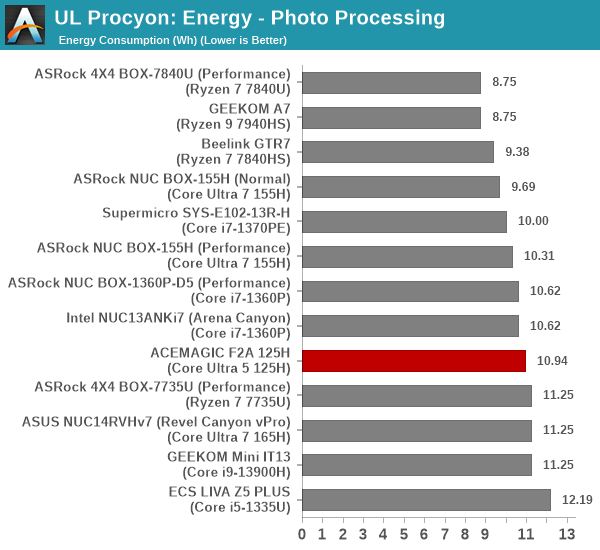
UL Procyon evaluates performance for video editing using Adobe Premier Pro. This utlizes the GPU component also, and the Ultra 5 carries a small penalty here. It manages to stay ahead of the Mini IT13's Core i8-13900H (albeit with an older iGPU architecture and a 35W limit) and the LIVA Z5 PLUS (20W Core i5-1335U) only.
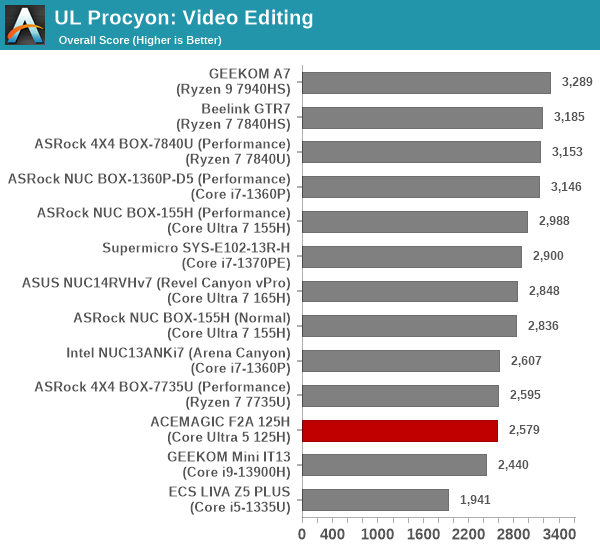
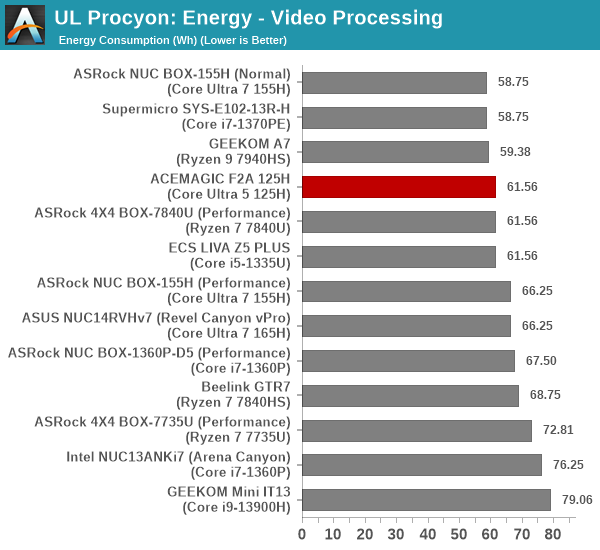
On a redeeming note, the combination of power consumption numbers and the time taken for benchmark completion manages to push the F2A 125H into the top half with respect to the energy consumption metric for video processing.
BAPCo CrossMark 1.0.1.86
BAPCo's CrossMark aims to simplify benchmark processing while still delivering scores that roughly tally with SYSmark. The main advantage is the cross-platform nature of the tool - allowing it to be run on smartphones and tablets as well.
| BAPCo CrossMark 1.0.1.86 - Sub-Category Scores | |||
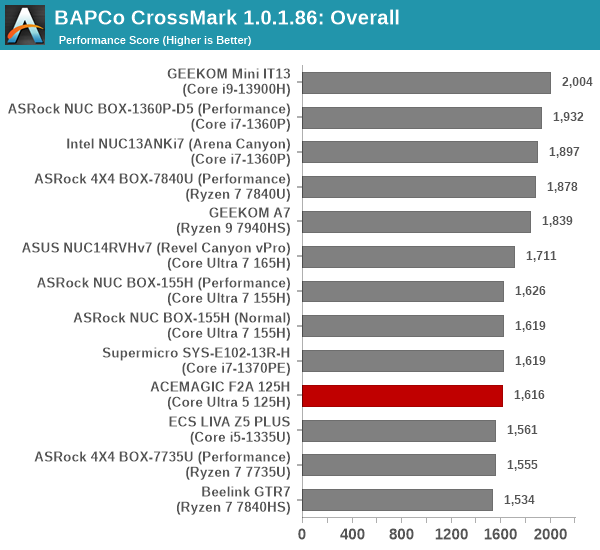
The relative performance seen in the PC Mark 10 workloads translate to CrossMark also, as expected. Things are quite dire for Meteor Lake here - almost all of the Raptor Lake-P systems perform better than the tested MTL-H configurations.
System Performance: Application-Specific Workloads
Standardized benchmarks such as UL's PCMark 10 and BAPCo's CrossMark take a holistic view of the system and process a wide range of workloads to arrive at a single score. Some systems are required to excel at specific tasks - so it is often helpful to see how a computer performs in specific scenarios such as rendering, transcoding, JavaScript execution (web browsing), etc. This section presents focused benchmark numbers for specific application scenarios.
3D Rendering - CINEBENCH R23
We use CINEBENCH R23 for 3D rendering evaluation. R23 provides two benchmark modes - single threaded and multi-threaded. Evaluation of different PC configurations in both supported modes provided us the following results.

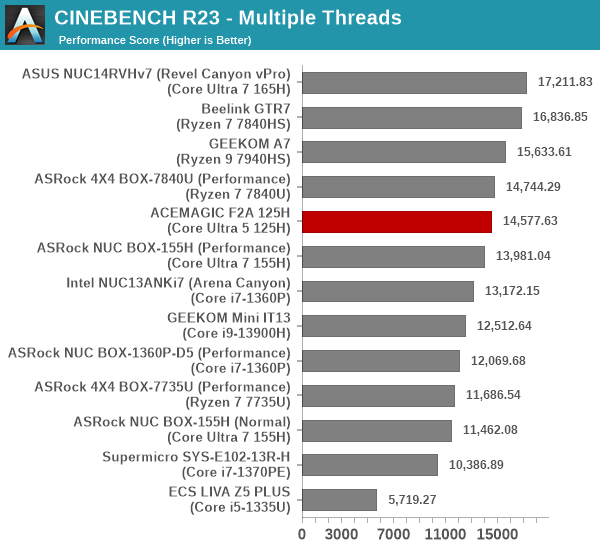
The scores are along expected lines for a system with only four high-performance cores (compared to 6 or 8 in most of the other systems), albeit with a 65W PL1 configuration.
Transcoding: Handbrake 1.5.1
Handbrake is one of the most user-friendly open source transcoding front-ends in the market. It allows users to opt for either software-based higher quality processing or hardware-based fast processing in their transcoding jobs. Our new test suite uses the 'Tears of Steel' 4K AVC video as input and transcodes it with a quality setting of 19 to create a 720p AVC stream and a 1080p HEVC stream.
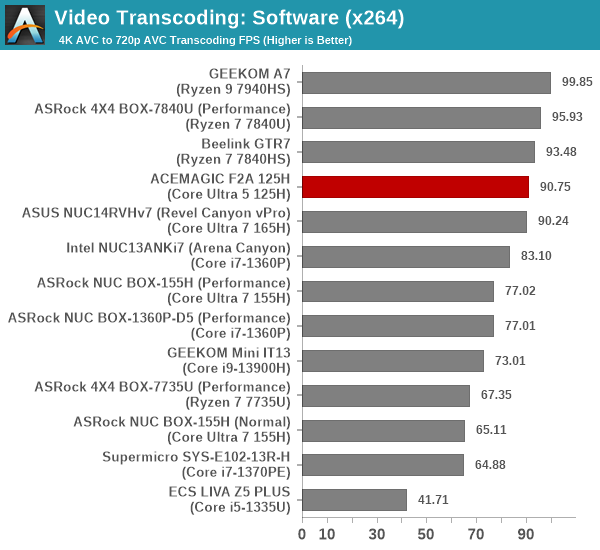
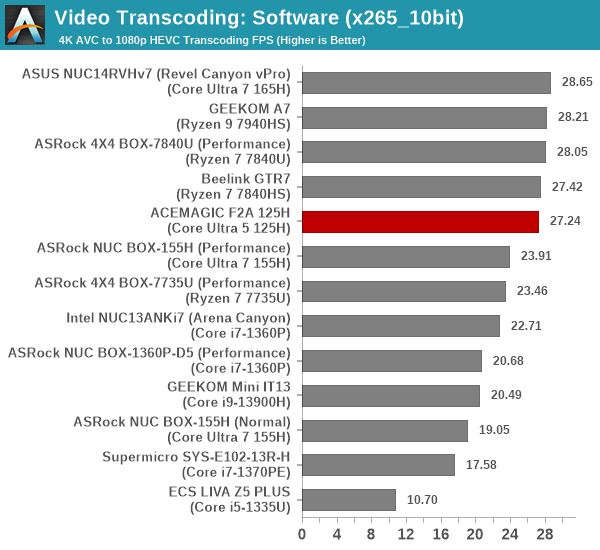
The more the number of available threads, and higher the available power budget, the better is the software transcoding performance. As a result, we see the 8 high-performance cores in the latest AMD systems helping to get past the 6 and 4 core configurations in the Meteor Lake ones. However, the NUC14RVHv7 is able to wrest back a narrow lead in the x265 encoding performance, thanks to its 64W power budget and 6 high-performance cores. With a similar power budget, the F2A 125H lags behind a bit in the x265 case because of the lowered high-performance core count.
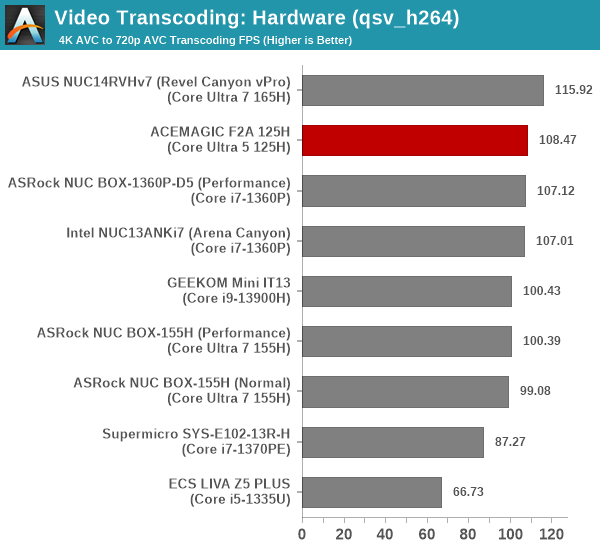
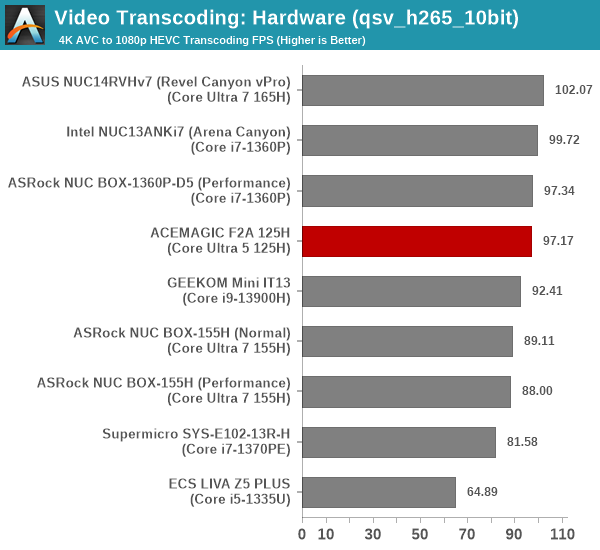
The QuickSync transcoding engine in the Revel Canyon NUC performs the best for hardware-accelerated transcoding. The F2A 125H is only slightly behind because of the similar power budget (64W vs 65W), but a slightly slower clock for the engine.
Archiving: 7-Zip 21.7
The 7-Zip benchmark is carried over from our previous test suite with an update to the latest version of the open source compression / decompression software.
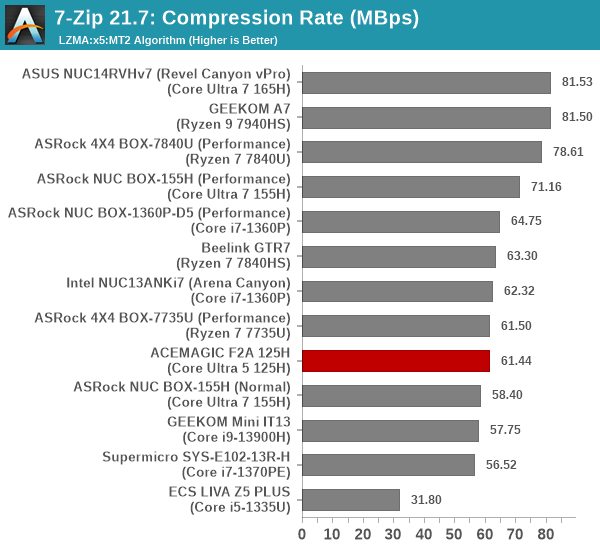
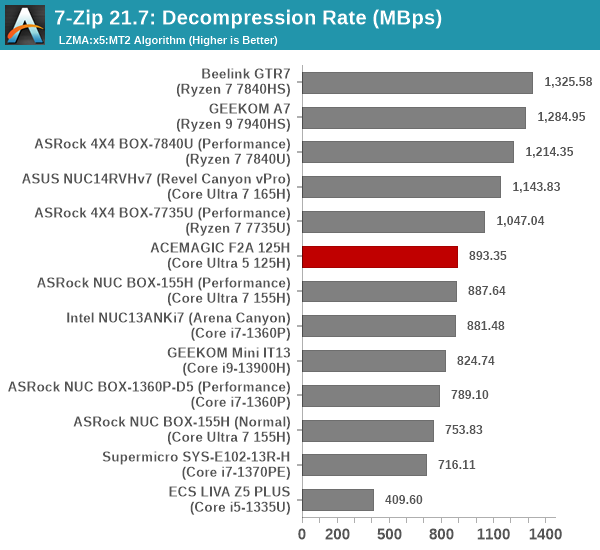
Despite the large power budget, the lack of high-performance cores proves to be detrimental in the archive processing case, as both compression and decompression workloads see the F2A 125H lean towards the middle of the pack.
Web Browsing: JetStream, Speedometer, and Principled Technologies WebXPRT4
Web browser-based workloads have emerged as a major component of the typical home and business PC usage scenarios. For headless systems, many applications based on JavaScript are becoming relevant too. In order to evaluate systems for their JavaScript execution efficiency, we are carrying over the browser-focused benchmarks from the WebKit developers used in our notebook reviews. Hosted at BrowserBench, JetStream 2.0 benchmarks JavaScript and WebAssembly performance, while Speedometer measures web application responsiveness.
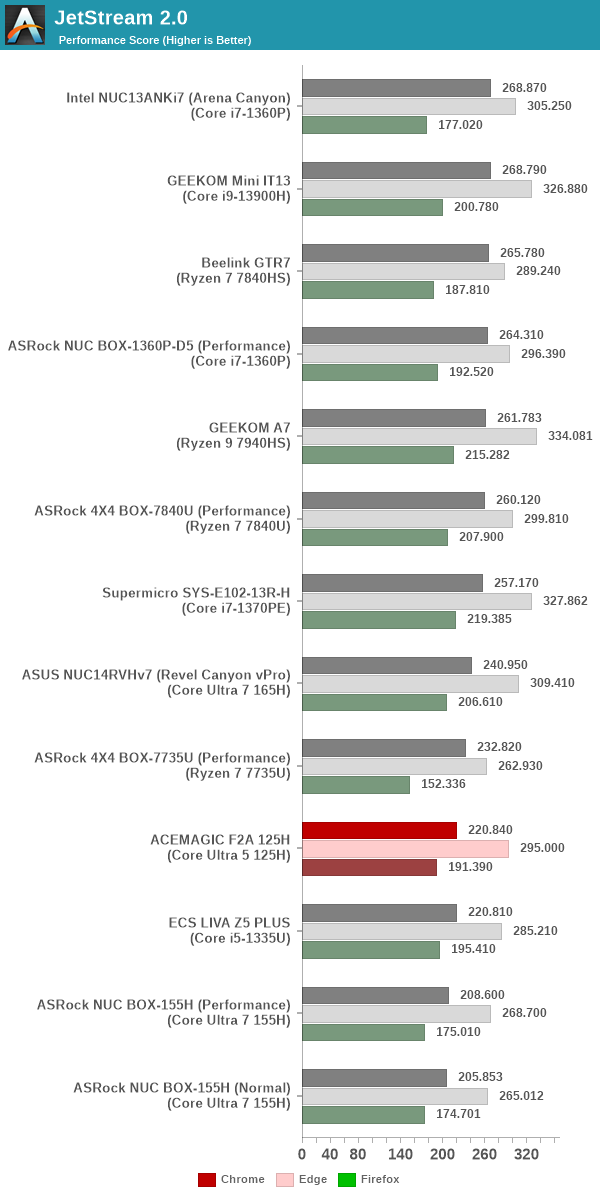
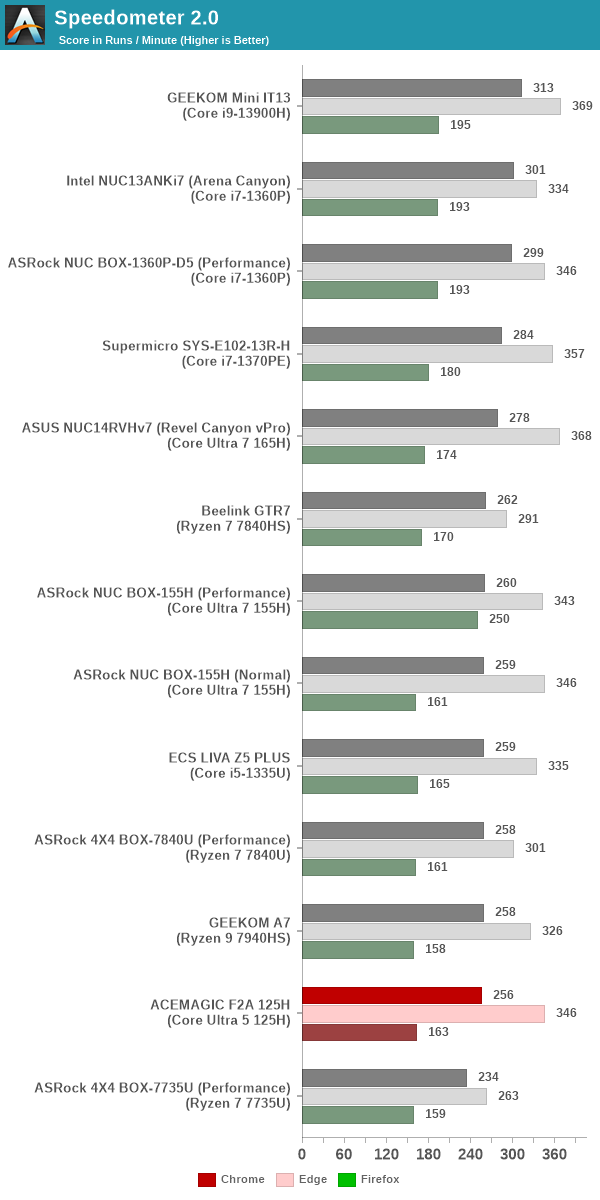
From a real-life workload perspective, we also process WebXPRT4 from Principled Technologies. WebXPRT4 benchmarks the performance of some popular JavaScript libraries that are widely used in websites.
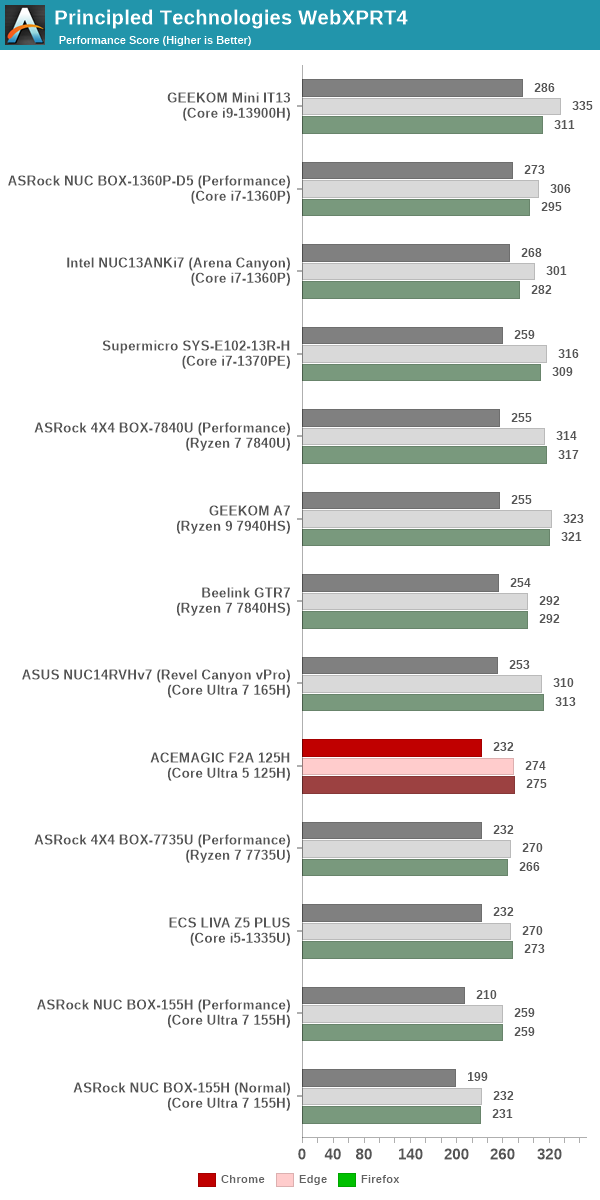
Web browser benchmarks have typically been an easy win for Intel-based systems because of their excellent single-threaded performance. However, Meteor Lake makes a not-so-impressive entry into the list with a middle-of-the-road performance across the board. It is only the F2A 125H's 65W PL1 configuration that prevents it from slipping to the bottom of the list.
Application Startup: GIMP 2.10.30
A new addition to our systems test suite is AppTimer - a benchmark that loads up a program and determines how long it takes for it to accept user inputs. We use GIMP 2.10.30 with a 50MB multi-layered xcf file as input. What we test here is the first run as well as the cached run - normally on the first time a user loads the GIMP package from a fresh install, the system has to configure a few dozen files that remain optimized on subsequent opening. For our test we delete those configured optimized files in order to force a fresh load every second time the software is run.
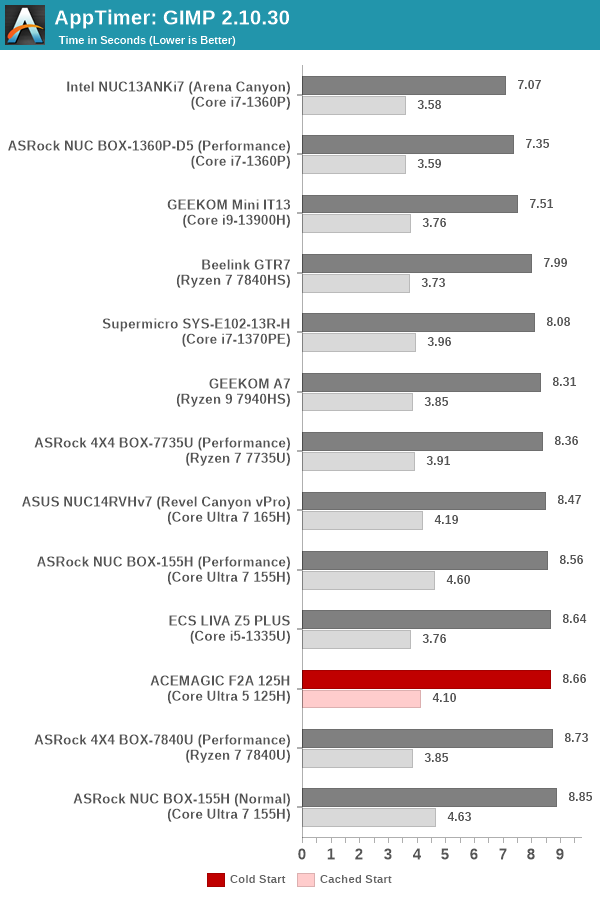
As it turns out, GIMP does optimizations for every CPU thread in the system, which requires that higher thread-count processors take a lot longer to run. So the test runs quick on systems with fewer threads, however fast cores are also needed. This combination is a bit of a penalty for hybrid processors. Allocation of the tasks to efficiency cores may result in a significant drop in user experience / response time. The 4P configuration of the F2A 125H at 65W does manage to edge out the 6P configuration of the NUC BOX-155H at 28W, but the latter's 40W avatar wrests back a slight lead to leave the ACEMAGIC system in the bottom half of the pack.
Cryptography Benchmarks
Cryptography has become an indispensable part of our interaction with computing systems. Almost all modern systems have some sort of hardware-acceleration for making cryptographic operations faster and more power efficient. In the case of IoT servers, many applications - including web server functionality and VPN - need cryptography acceleration.
BitLocker is a Windows features that encrypts entire disk volumes. While drives that offer encryption capabilities are dealt with using that feature, most legacy systems and external drives have to use the host system implementation. Windows has no direct benchmark for BitLocker. However, we cooked up a BitLocker operation sequence to determine the adeptness of the system at handling BitLocker operations. We start off with a 4.5GB RAM drive in which a 4GB VHD (virtual hard disk) is created. This VHD is then mounted, and BitLocker is enabled on the volume. Once the BitLocker encryption process gets done, BitLocker is disabled. This triggers a decryption process. The times taken to complete the encryption and decryption are recorded. This process is repeated 25 times, and the average of the last 20 iterations is graphed below.
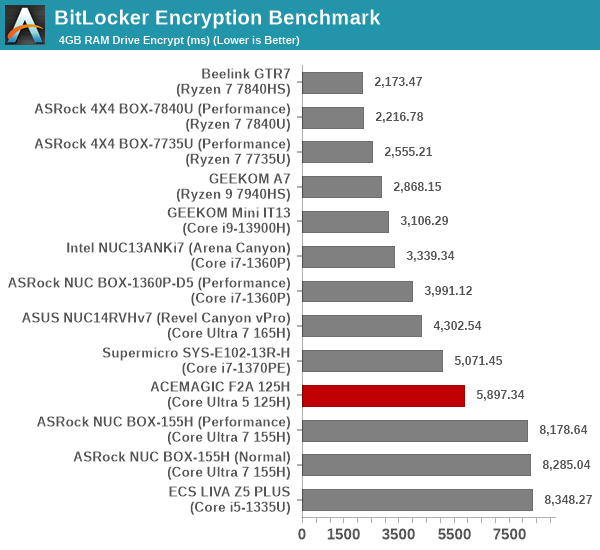
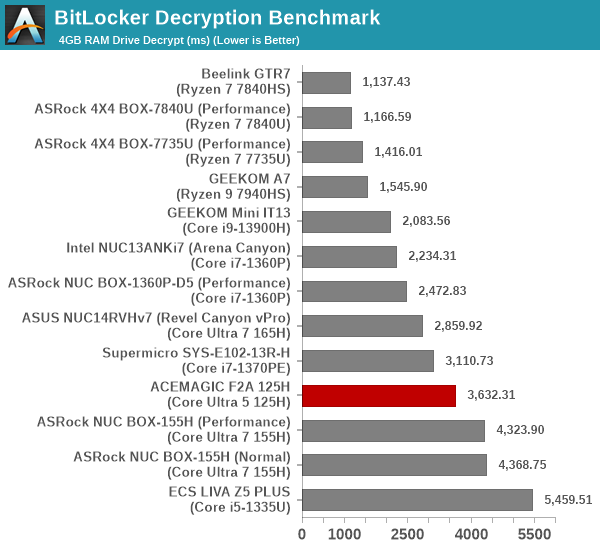
Hardware acceleration is available for the operations in all of the systems. The time taken for processing is directly dependent on the available power budget. Slotting in behind Raptor Lake-P systems despite a higher available power budget is a worrying trend for the MTL-H systems. While the 4P configuration could be cited as a reason for the F2A's position in the above graphs, we find that its 65W PL1 enables an edge over the 28W and 40W 6P configurations.
GPU Performance: Synthetic Benchmarks
The integrated GPU in Meteor Lake-H is a pared down version of the one used in Intel's discrete Arc GPUs. The Meteor Lake-H architecture isolates the media engine and display pipe away from the GPU tile. The new iGPU also includes ray-tracing support.
GPU performance evaluation typically involved gaming workloads, and for select PCs, GPU compute. Prior to that, a look at the capabilities of the GPU in the Core Ultra 5 125H is warranted.
The Intel Arc Graphics in MTL-H is a completely new architecture for the mobile processor market. The iGPU in the F2A processor has one less Xe core, and is also clocked slightly lower. However, it is still good enough to regain parity with the RDNA3-based iGPU in the AMD-based systems, as shown in the benchmarks below.
GFXBench
The DirectX 12-based GFXBench tests from Kishonti are cross-platform, and available all the way down to smartphones. As such, they are not very taxing for discrete GPUs and modern integrated GPUs. We processed the offscreen versions of the 'Aztec Ruins' benchmark.
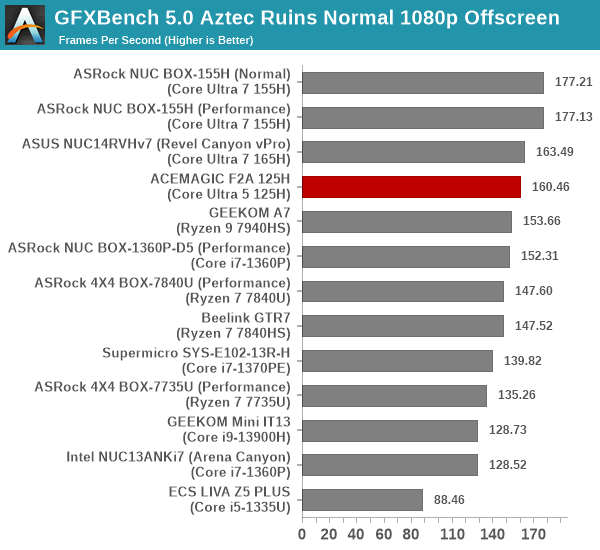
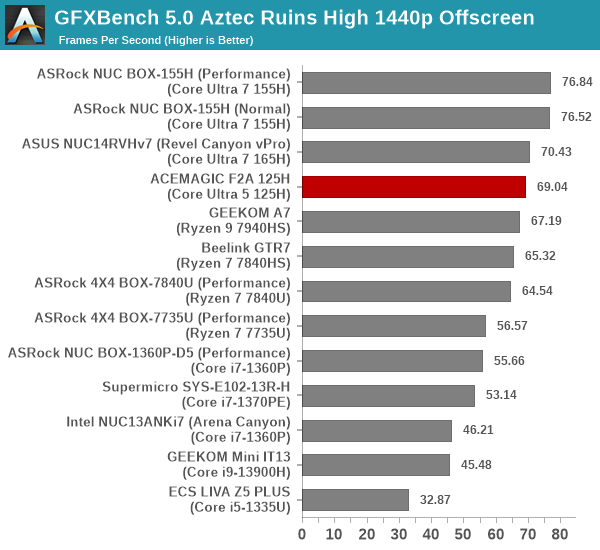
The numbers depend on the iGPU's power budget allocation, and not just on the PL1 of the package. That said, we see that the F2A 125H and the NUC14RVHv7 perform similarly, with the small delta being attributable to the lowered Xe core count and clock speed.
UL 3DMark
Four different workload sets were processed in 3DMark - Fire Strike, Time Spy, Night Raid, and Wild Life.
3DMark Fire Strike
The Fire Strike benchmark has three workloads. The base version is meant for high-performance gaming PCs. It uses DirectX 11 (feature level 11) to render frames at 1920 x 1080. The Extreme version targets 1440p gaming requirements, while the Ultra version targets 4K gaming system, and renders at 3840 x 2160. The graph below presents the overall score for the Fire Strike Extreme and Fire Strike Ultra benchmark across all the systems that are being compared.
| UL 3DMark - Fire Strike Workloads | |||
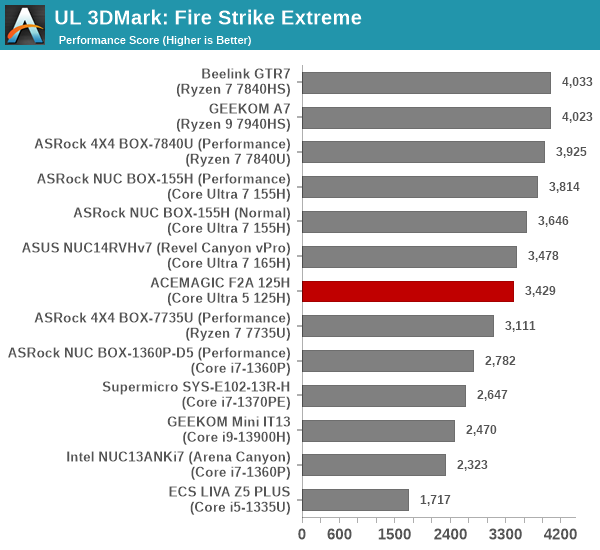
The RDNA3 iGPU in the Phoenix-based systems manages to come out on top in the two workloads, but the Meteor Lake-based systems are right behind, with the internal ordering the same as what was observed in the previous test.
3DMark Time Spy
The Time Spy workload has two levels with different complexities. Both use DirectX 12 (feature level 11). However, the plain version targets high-performance gaming PCs with a 2560 x 1440 render resolution, while the Extreme version renders at 3840 x 2160 resolution. The graphs below present both numbers for all the systems that are being compared in this review.
| UL 3DMark - Time Spy Workloads | |||
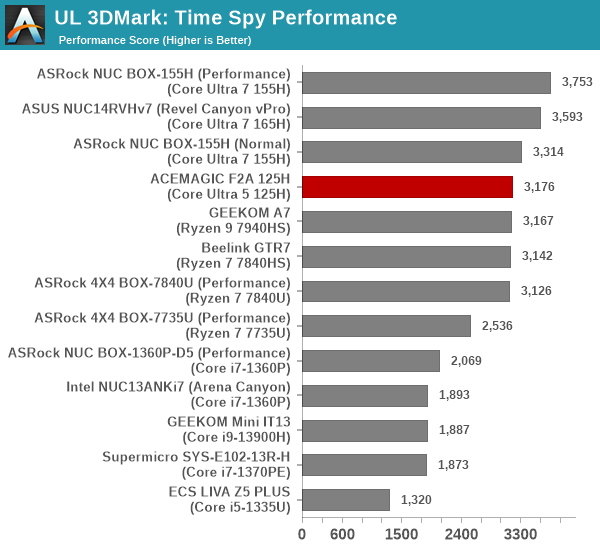
The Arc iGPU in Meteor Lake takes up the top four spots in both Time Spy configurations, as shown above. The two Phoenix-based systems take up the next two spots.
3DMark Wild Life
The Wild Life workload was initially introduced as a cross-platform GPU benchmark in 2020. It renders at a 2560 x 1440 resolution using Vulkan 1.1 APIs on Windows. It is a relatively short-running test, reflective of mobile GPU usage. In mid-2021, UL released the Wild Life Extreme workload that was a more demanding version that renders at 3840 x 2160 and runs for a much longer duration reflective of typical desktop gaming usage.
| UL 3DMark - Wild Life Workloads | |||
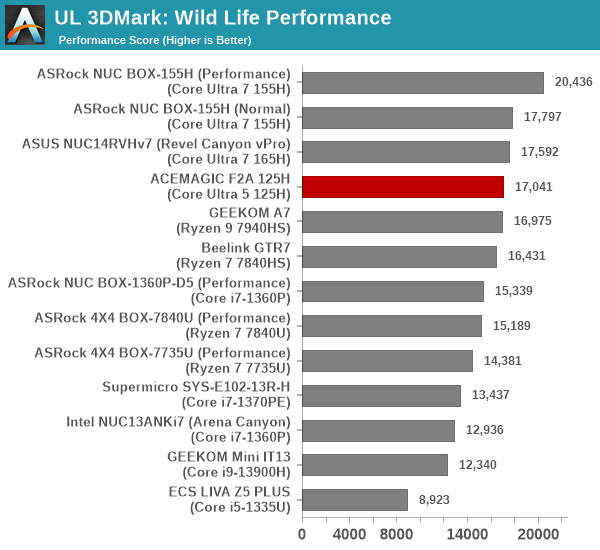
The 1440p version sees the Meteor Lake-based systems on top, but the 4K version sees a much closer fight. The Phoenix-based systems take up three of the first four spots, with the 40W NUC BOX-155H sneaking in-between (thanks to its iGPU power budget allocation). The F2A 125H remains consistently just behind the NUC14RVHv7.
3DMark Night Raid
The Night Raid workload is a DirectX 12 benchmark test. It is less demanding than Time Spy, and is optimized for integrated graphics. The graph below presents the overall score in this workload for different system configurations.
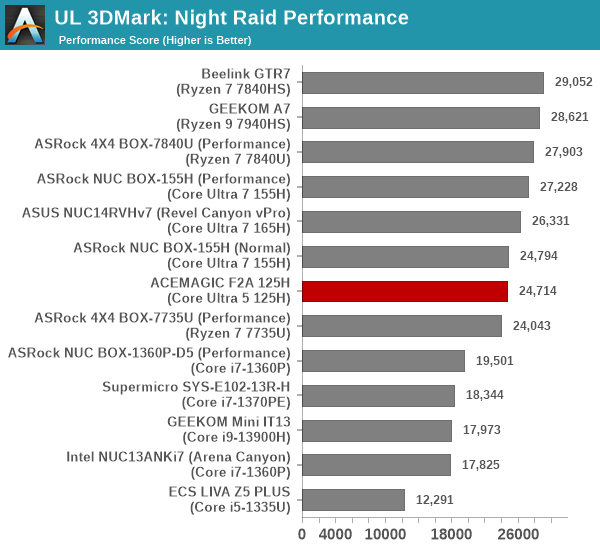
RDNA3 scores a win here, with the Phoenix-based systems taking up the top three spots and followed immediately by the four MTL-H configurations.
3DMark Port Royal
UL introduced the Port Royal ray-tracing benchmark as a DLC for 3DMark in early 2019. The scores serve as an indicator of how the system handles ray-tracing effects in real-time.
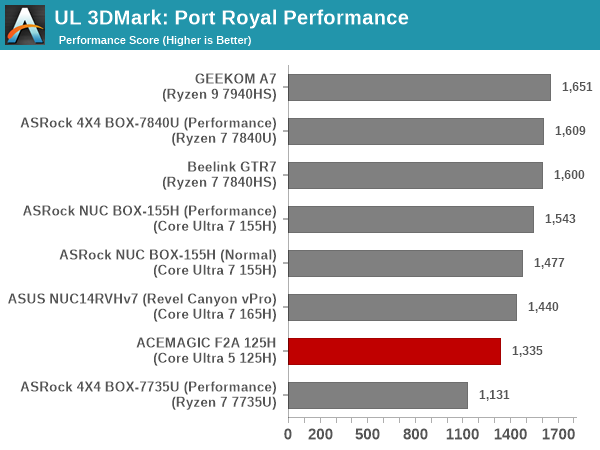
RDNA3's ray tracing performance is slightly better than that of MTL-H. The RDNA2 ray tracing in the Rembrandt SoC makes up the bottom half of the pack.
AI Performance: UL Procyon AI Workloads
Drafting a set of benchmarks relevant to end-user AI use-cases has proved to be a challenging exercise. While training workloads are common in the datacenter and enterprise space, consumer workloads are focused on inference. In early days, the inferencing used to run in the cloud, but increasing privacy concerns, as well as the penalties associated with constant cloud communication, have contributed to the rise in demand for local inferencing capabilities. Additionally, generative AI (such as chatbots and image generators based on input prompts) has also garnered significant interest in recent days. Currently, most of these large-language models (LLMs) run in the cloud, as they are still too resource-heavy to run with reasonable performance in the systems of average users.
UL's Procyon AI benchmarks focuses on these workloads from an edge computing perspective. Broadly speaking, the benchmark is divided into two major components:
- Computer Vision (inference performance using six different neural network models)
- Generative AI (image generation using the Stable Diffusion LLM)
An attempt was made to process both benchmarks on the ACEMAGIC F2A 125H as part of the evaluation of its capabilities as an "AI PC". The results are summarized in the remainder of this section.
Computer Vision Neural Networks Performance
The six supported neural networks were benchmarked with the following configurations:
- OpenVINO CPU with float32 precision
- OpenVINO GPU with float16 precision
- OpenVINO GPU with float32 precision
- OpenVINO GPU With integer precision
- OpenVINO NPU with float16 precision
- OpenVINO NPU with integer precision
- WinML GPU with float16 precision
- WinML GPU with float32 precision
- WinML GPU with integer precision
The OpenVINO configurations can be evaluated only on systems with an Intel CPU or GPU or NPU. In general, a neural network model's accuracy / quality of results improves with precision. In other words, we expect float16 to deliver better results than integer, and float32 to be better than float16. However, increased precision requires more complex calculations and that results in higher power consumption. As general purpose engines, the CPU is expected to be the most power hungry of the lot, while the NPUs which are purpose-built for neural network acceleration are expected to be better than the GPU configurations. UL has a detailed study of the variation in the quality of results with precision for different networks in their benchmark resources section.
The YOLO V3 network is used for real-time object detection in videos. The graphs below show that at the same precision, OpenVINO performs better than WinML on the GPU. Additionally, for the same precision, OpenVINO performs better on the GPU rather than the NPU
| UL Procyon AI - YOLO V3 Average Inference Time | |||
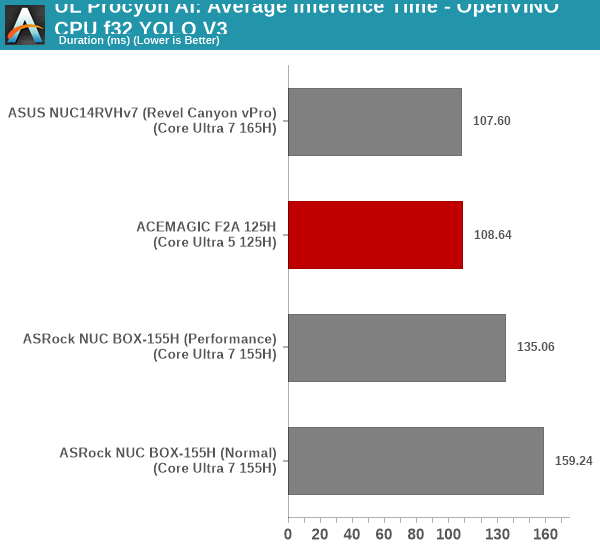
The REAL ESRGAN network is used for upscaling images / restoration of videos and pictures. Relative performance for different precisions / execution hardware is similar to what was seen for the YOLO V3 network.
| UL Procyon AI - REAL ESRGAN Average Inference Time | |||
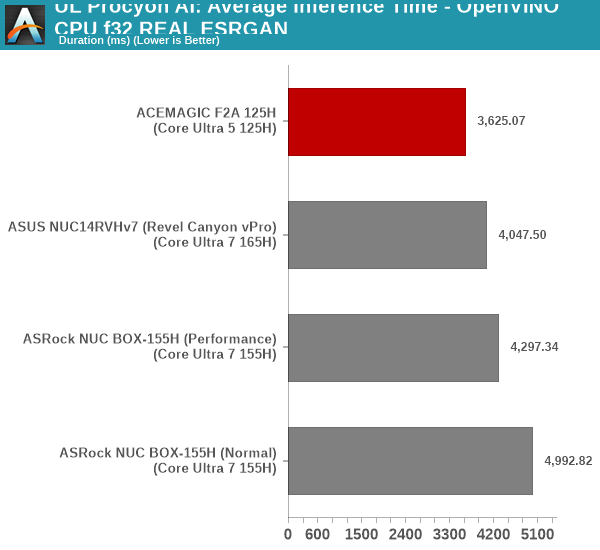
The ResNet 50 network is primarily used for image classification. Again, we see the NPU being slower than the GPU at the same precision, while WinML lags behind OpenVINO for the same underlying execution hardware and precision.
| UL Procyon AI - ResNet 50 Average Inference Time | |||
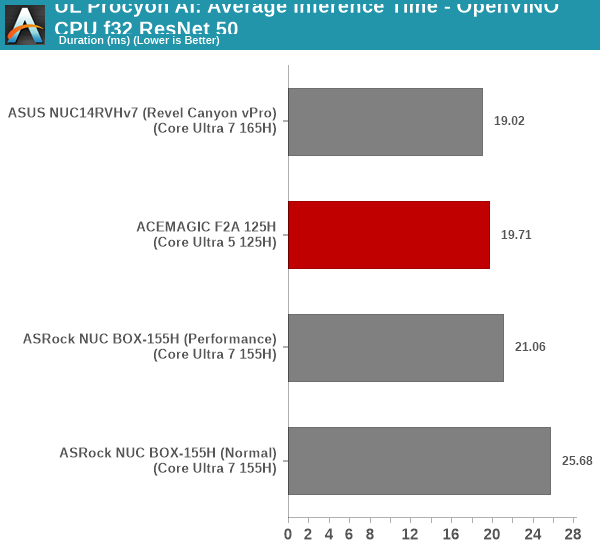
The MobileNet V3 network is used, among other things, for image processing tasks such as tilt correction. Similar to the other networks, WinML again lags behind OpenVINO. However, the NPU is faster than the GPU for the same precision network.
| UL Procyon AI - MobileNet V3 Average Inference Time | |||

The Inception V4 network, like the ResNet 50, is primarily used for image classification. Similar to most other networks, WinML performance is not as good as with OpenVINO, and the NPU is slower than the GPU for the same precision.
| UL Procyon AI - Inception V4 Average Inference Time | |||
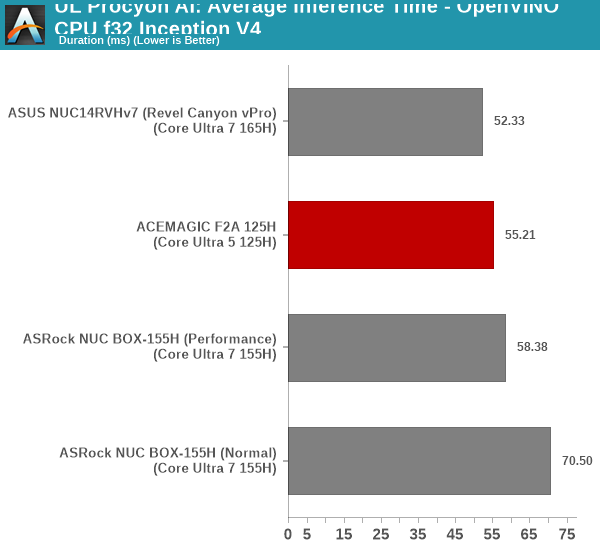
The DeepLab V3 network is used for image segmentation. In other words, it identifies groups of pixels in an image that satisfies specific requirements. The NPU is almost 4x slower than the GPU for the same precision and network. OpenVINO continues to perform better than WinML for the same precision network.
| UL Procyon AI - DeepLab V3 Average Inference Time | |||
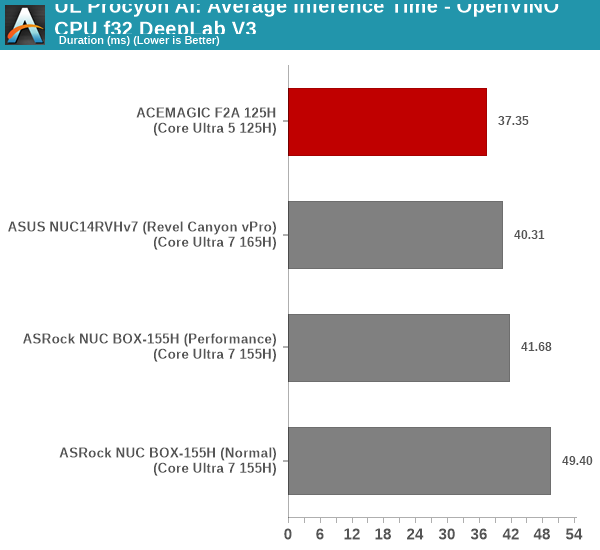
The UL Procyon AI Computer Vision benchmark run processes each model for 3 minutes, maintaining a count of inferences as well as the average time taken for each inference. It presents an overall score for all six models together, though it is possible that some networks perform better than others for the same hardware / precision configuration.
| UL Procyon AI - Computer Vision Inferencing Overall Scores | |||
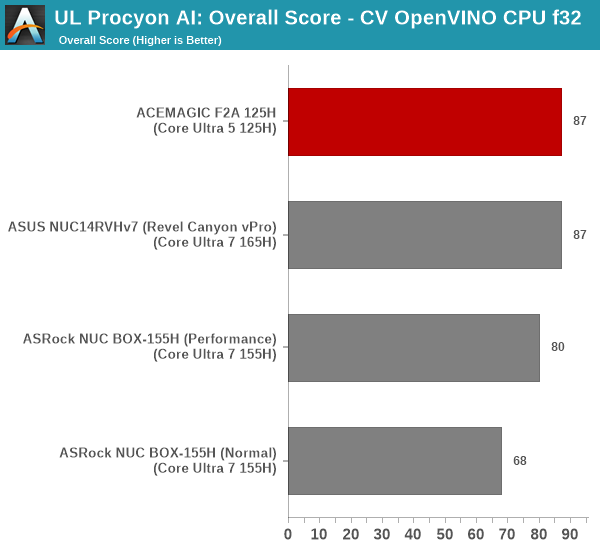
The Revel Canyon NUC and the F2A 125H come out on top in the CPU-only OpenVINO run with float32 precision. For the OpenVINO GPU runs, the NUC BOX-155H manages to sneak in a slight lead over the other systems. Finally, WinML performance is quite bad compared to OpenVINO.
The benchmark runs for a fixed time. Hence, instead of tracking energy consumption, we opt to report the average at-wall power consumption for the system as a whole for each run set.
| UL Procyon AI - Computer Vision Average Power Consumption | |||
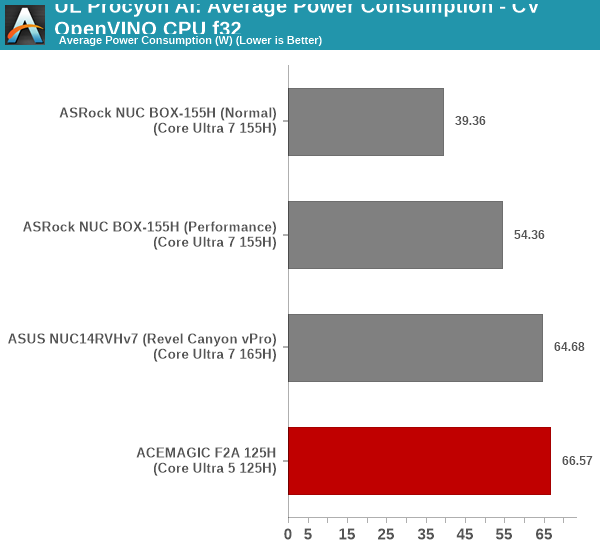
As expected, the NPU is the most power-efficient of the lot. Higher precision translates to higher power consumption, and CPU mode is the least power-efficient.
Generative AI Performance
The Stability Diffusion prompt used for benchmarking in UL Procyon AI generates 16 different images. However, on all three system configurations, the benchmark crashed after generating 3 or 4 images. This benchmark is meant for high-end systems with discrete GPUs, and hence we didn't bother to follow up on the crashes.
As we get more systems processed with the UL Procyon AI benchmark, an attempt will be made to get the Generative AI benchmark working on them.
HTPC Credentials
The 2022 Q4 update to our system reviews brings an updated HTPC evaluation suite for systems. After doing away with the evaluation of display refresh rate stability and Netflix streaming evaluation, the local media playback configurations have also seen a revamp. This section details each of the workloads processed on the ACEMAGIC F2A 125H as part of the HTPC suite. Prior to that, a discussion of the changes in MTL-H relevant to multimedia processing is in order.
Meteor Lake moves the media engine (decoder / encoder) as well as the display engine away from the GPU tile to the SoC tile. The media engine supports a variety of codecs and also supports limited video post-processing.
YouTube Streaming Efficiency
YouTube continues to remain one of the top OTT platforms, primarily due to its free ad-supported tier. Our HTPC test suite update retains YouTube streaming efficiency evaluation as a metric of OTT support in different systems. Mystery Box's Peru 8K HDR 60FPS video is the chosen test sample. On PCs running Windows, it is recommended that HDR streaming videos be viewed using the Microsoft Edge browser after putting the desktop in HDR mode.
The GPU in ACEMAGIC F2A 125H supports hardware decoding of AV1, and we see the stream encoded with that codec being played back. The streaming is perfect, thanks to the powerful GPU and hardware decoding support - the number of dropped frames observed in the statistics above are due to mouse clicks involved in bringing up the overlay.
The streaming efficiency-related aspects such as GPU usage and at-wall power consumption are also graphed below.

Since almost all of the processing for streaming occurs in the SoC tile, the MTL-H systems are quite frugal in the energy consumption aspect for the job. That said, we do see that the F2A is not as efficient as the NUC14RVHv7 despite similar PL1 numbers.
Hardware-Accelerated Encoding and Decoding
The transcoding benchmarks in the systems performance section presented results from evaluating the QuickSync encoder within Handbrake's framework. We usually check the capabilities of the decoder engine using DXVAChecker, but the software (4.6.0) unfortunately crashes while attempting to execute processes in some DLLs in the Arc GPU drivers. Fortunately, Intel has a comprehensive table of supported codecs and pixel formats in the media engine.

Video Decoding Hardware Acceleration in the ACEMAGIC F2A 125H
The supported codecs list is good enough even for professional applications.
Local Media Playback
Evaluation of local media playback and video processing is done by playing back files encompassing a range of relevant codecs, containers, resolutions, and frame rates. A note of the efficiency is also made by tracking GPU usage and power consumption of the system at the wall. Users have their own preference for the playback software / decoder / renderer, and our aim is to have numbers representative of commonly encountered scenarios. Our Q4 2022 test suite update replaces MPC-HC (in LAV filters / madVR modes) with mpv. In addition to being cross-platform and open-source, the player allows easy control via the command-line to enable different shader-based post-processing algorithms. From a benchmarking perspective, the more attractive aspect is the real-time reporting of dropped frames in an easily parseable manner. The players / configurations considered in this subsection include:
- VLC 3.0.20
- Kodi 21.0
- mpv 0.38.2 (hwdec auto, vo=gpu-next)
- mpv 0.38.2 (hwdec auto, vo=gpu-next, profile=gpu-hq)
Fourteen test streams (each of 90s duration) were played back from the local disk with an interval of 30 seconds in-between. Various metrics including GPU usage, at-wall power consumption, and total energy consumption were recorded during the course of this playback.
All our playback tests were done with the desktop HDR setting turned on. It is possible for certain system configurations to automatically turn on/off the HDR capabilities prior to the playback of a HDR video, but, we didn't take advantage of that in our testing.
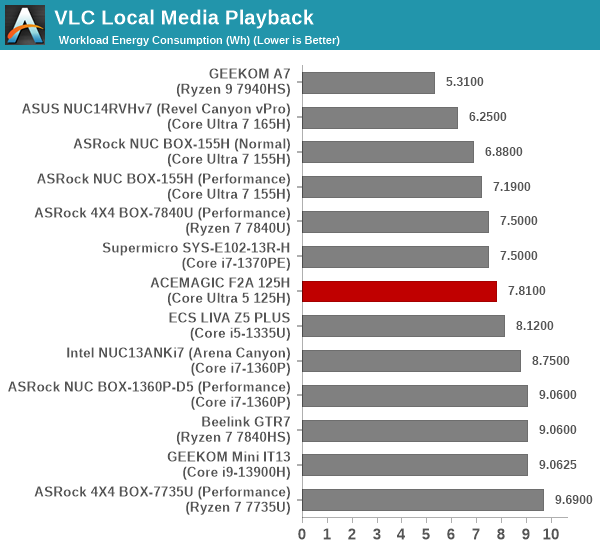
Restricting the decoding and rendering activity to the SoC tile helps in keeping the energy consumption numbers low, but the F2A is not as efficient as the other MTL-H configurations.
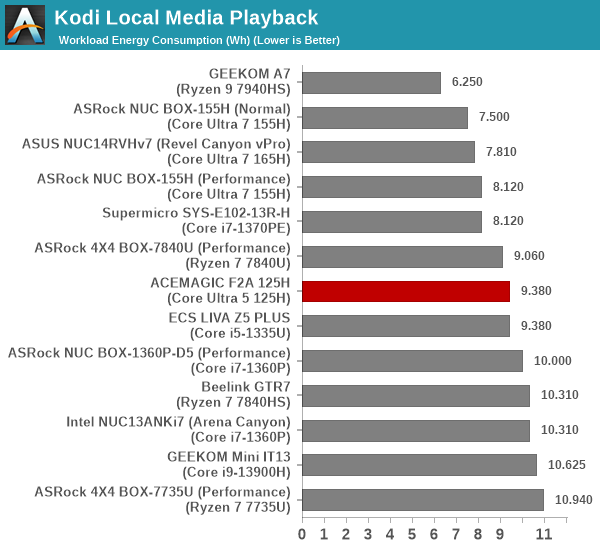
The energy efficiency trend seen in the VLC case is repeated here also.
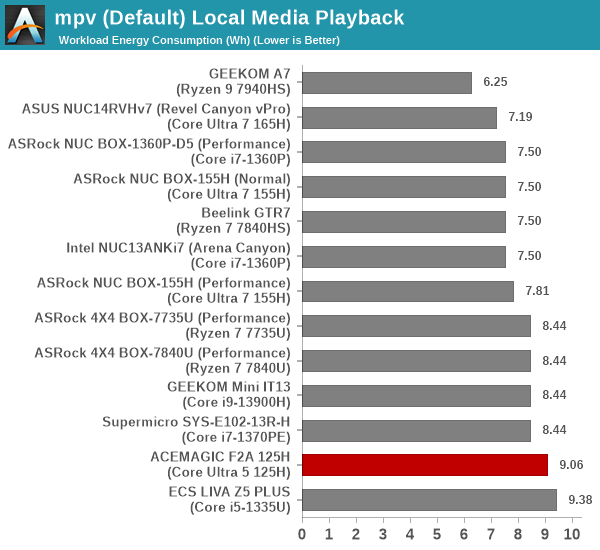
The F2A is not particularly energy efficient for the mpv playback case, making its entry in the bottom half.
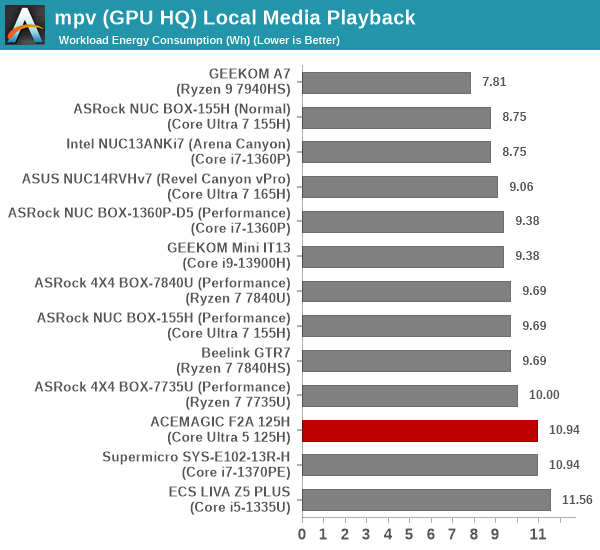
The additional iGPU activity with the GPU-HQ setting (along with the associated GPU - SoC tiles communication) tends to increase the energy consumption numbers over the vanilla mpv default playback case, as shown in the above graph.
Power Consumption and Thermal Characteristics
The power consumption at the wall was measured with a 4K display being driven through one of the HDMI ports of the system. In the graph below, we compare the idle and load power of the ACEMAGIC F2A 125H with other systems evaluated before. For load power consumption, we ran the AIDA64 System Stability Test with various stress components, as well as our custom stress test with Prime95 / Furmark, and noted the peak as well as idling power consumption at the wall.
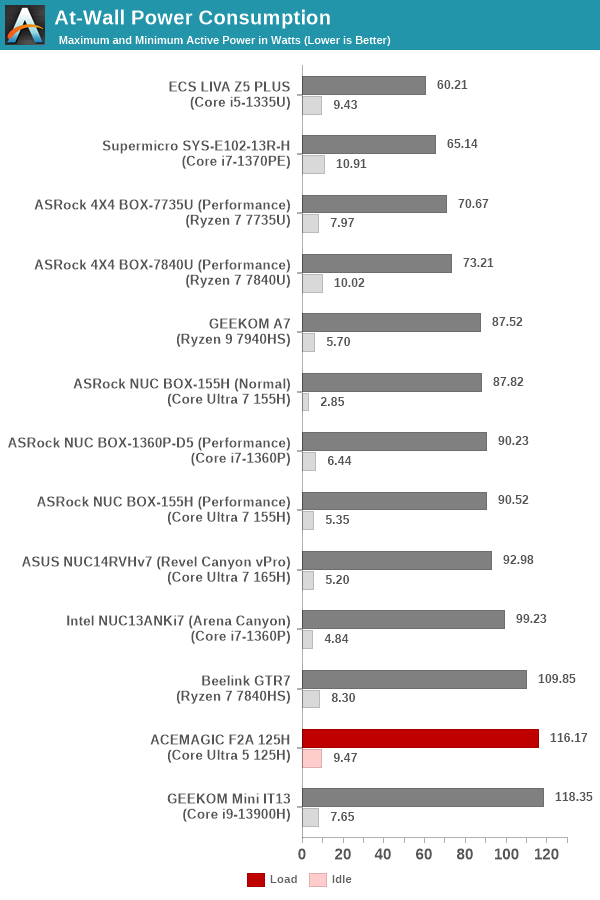
The numbers are consistent with the TDP and suggested PL1 / PL2 values for the processors in the systems, and do not come as any surprise. With a 90W PL2 setting, we find the peak power consumption of the F2A 125H to be around 116W. Idle numbers could be a bit better with some BIOS optimizations.
Stress Testing
Our thermal stress routine is a combination of Prime95, Furmark, and Finalwire's AIDA64 System Stability Test. The following 9-step sequence is followed, starting with the system at idle:
- Start with the Prime95 stress test configured for maximum power consumption
- After 30 minutes, add Furmark GPU stress workload
- After 30 minutes, terminate the Prime95 workload
- After 30 minutes, terminate the Furmark workload and let the system idle
- After 30 minutes of idling, start the AIDA64 System Stress Test (SST) with CPU, caches, and RAM activated
- After 30 minutes, terminate the previous AIDA64 SST and start a new one with the GPU, CPU, caches, and RAM activated
- After 30 minutes, terminate the previous AIDA64 SST and start a new one with only the GPU activated
- After 30 minutes, terminate the previous AIDA64 SST and start a new one with the CPU, GPU, caches, RAM, and SSD activated
- After 30 minutes, terminate the AIDA64 SST and let the system idle for 30 minutes
Traditionally, this test used to record the clock frequencies - however, with the increasing number of cores in modern processors and fine-grained clock control, frequency information makes the graphs cluttered and doesn't contribute much to understanding the thermal performance of the system. The focus is now on the power consumption and temperature profiles to determine if throttling is in play.
The thermal solution of the F2A 125H is good enough to let the processor package operate with a sustained 65W package power. We see that the number stays right around that mark all through the segments where the CPU is stressed. Additionally, the core temperature never crosses 85C throughout this duration. The SSD temperature goes up to 64C under heavy stress, but stays as cool as 40C during other periods. The SODIMMs also stay well south of 60C in the whole process.
Real-World Thermals and Power Consumption
Beyond the extreme synthetic tests above, it is also useful to get an ideal of the thermal behavior and power consumption numbers for common consumer workloads. For this purpose, we again turn to UL's Procyon benchmark. Results from the benchmark were presented in a previous section. In this sub-section, results gathered from the simultaneous built-in system monitoring thread are presented.
| UL Procyon Office Workload Package Temperature and At-Wall Power Consumption |
||||
| System | Cores Temperature (C) | At-Wall Power (Average) (W) |
||
| Minimum | Average | Maximum | ||
| ASRock NUC BOX-155H (Performance) | 42 | 55.36 | 93 | 29.41 |
| ACEMAGIC F2A 125H | 27 | 33.42 | 64 | 26.58 |
| ASUS NUC14RVHv7 (Revel Canyon vPro) | 41.01 | 51.41 | 85 | 28.02 |
| ASRock NUC BOX-155H (Normal) | 45 | 58.1 | 98.61 | 27.02 |
The delta in the average power consumption at the wall is less than 3W for the F2A 125H, but this translates to a delta of more than 21C for the maximum temperature in the Office workload case.
| UL Procyon Photo Processing Package Temperature and At-Wall Power Consumption |
||||
| System | Cores Temperature (C) | At-Wall Power (Average) (W) |
||
| Minimum | Average | Maximum | ||
| ASRock NUC BOX-155H (Performance) | 44 | 63.92 | 110 | 40.58 |
| ACEMAGIC F2A 125H | 27.6 | 37.11 | 68.09 | 37.7 |
| ASUS NUC14RVHv7 (Revel Canyon vPro) | 42 | 59.43 | 111.69 | 42.17 |
| ASRock NUC BOX-155H (Normal) | 47 | 64.38 | 109.91 | 35.34 |
A similar trend is seen for the photo processing workload, with the maximum temperature being south of 70C for the ACEMAGIC system.
| UL Procyon Video Processing Package Temperature and At-Wall Power Consumption |
||||
| System | Cores Temperature (C) | At-Wall Power (Average) (W) |
||
| Minimum | Average | Maximum | ||
| ASRock NUC BOX-155H (Performance) | 45 | 77.19 | 110 | 47.39 |
| ACEMAGIC F2A 125H | 28 | 40.32 | 60.98 | 43.14 |
| ASUS NUC14RVHv7 (Revel Canyon vPro) | 49 | 68.17 | 101 | 51.17 |
| ASRock NUC BOX-155H (Normal) | 50 | 71.75 | 106.91 | 40.45 |
The F2A 125H again hits it out of the park with a 61C peak temperature in the video processing workload.
The larger physical footprint enables a much better thermal solution for the ACEMAGIC F2A 125H compared to the 4x4 systems. This is reflected very well in the real world thermal characteristics and also backs up our inferences from the synthetic stress tests sequence.
Miscellaneous Aspects and Concluding Remarks
Networking and storage are aspects that may be of vital importance in specific PC use-cases. The ACEMAGIC F2A 125H comes with a 2.5 GbE LAN port backed by a Realtek RTL8125 controller. The system is equipped with an Intel BE200 WLAN card - 2T2R 802.11be (Wi-Fi 7) with 320 MHz channels for up to 5.8 Gbps of theoretical throughput. The card also includes Bluetooth 5.4 support.
On the storage side, ACEMAGIC has equipped the F2A 125H with a Kingston Design-In SSD. The drive is a DRAM-less one with claimed read/write speeds well south of 4 GBps. Being a DRAM-less drive, that is not surprising. The drive used by ACEMAGIC (OM8SEP41024Q-A0) utilizes a Silicon Motion SM2267XT controller and BiCS5 3D TLC NAND. It barely meets the performance numbers expected out of a PCIe 4.0 x4 drive, but allows the company to market the system as one equipped with a Gen4 SSD.
From a benchmarking perspective, we provide results from the WPCstorage test of SPECworkstation 3.1. This benchmark replays access traces from various programs used in different verticals and compares the score against the one obtained with a 2017 SanDisk 512GB SATA SSD in the SPECworkstation 3.1 reference system.
| SPECworkstation 3.1.0 - WPCstorage SPEC Ratio Scores | |||
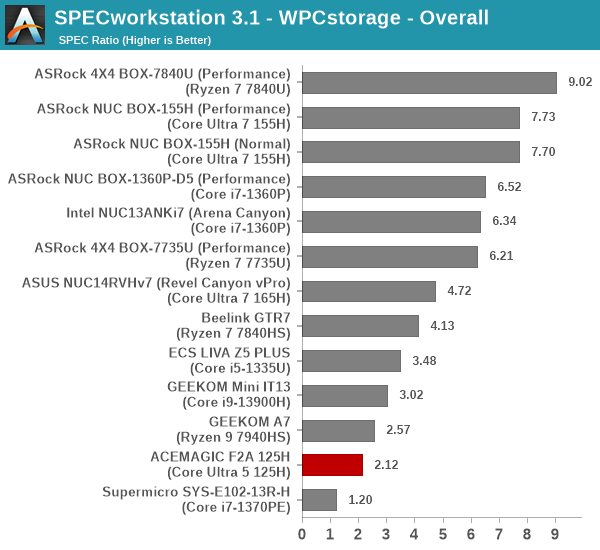
The graphs above present results for different verticals, as grouped by SPECworkstation 3.1. The storage workload consists of 60 subtests. Access traces from CFD solvers and programs such as Catia, Creo, and Soidworks come under 'Product Development'. Storage access traces from the NAMD and LAMMPS molecular dynamics simulator are under the 'Life Sciences' category. 'General Operations' includes access traces from 7-Zip and Mozilla programs. The 'Energy' category replays traces from the energy-02 SPECviewperf workload. The 'Media and Entertainment' vertical includes Handbrake, Maya, and 3dsmax. Given that the comparison is between a wide range of modern systems (almost all of which have been equipped with mid-range / high-end Gen4 SSDs), the appearance of the F2A 125H in the bottom half of the pack across all workloads is not surprising.
Closing Thoughts
The ACEMAGIC F2A 125H provided us with the opportunity to evaluate a mid-range Meteor Lake system. Note that the Core Ultra 5 125H is the entry-level MTL-H part, but is decidedly mid-range when the MTL-U lineup is also considered. ACEMAGIC has demonstrated that a stable 65W PL1 setting with excellent temperature profiles can be achieved by sacrificing a bit on the physical footprint front. For specific workloads, the 65W PL1 setting can make up for the lack of high-performance cores compared to the UCFF systems using the Core Ultra 7 155H in the 28W - 40W range.
ACEMAGIC heavily promotes the AI PC capabilities of the system. The industry as a whole is pushing that trend. The integration of an NPU (the Movidius VPU3720) enables acceleration of different neural networks and AI applications. Intel and its partners have realized that these continue to remain in the domain of developers and advanced users for now. In a bid to open them up to the mass market, sample applications are being developed using Intel's customized models for different computer vision tasks. While companies like ASRock Industrial are offering software packs as a free download as part of this endeavor, ACEMAGIC has not done anything specific on that front.
While this type of AI push is welcome, mass market adoption is going to be completely reliant on real-world use-cases such as querying of private photo albums, or automatic indexing and querying of videos from network cameras, and other such applications. It will take a few more years for these types of applications to become pervasive, and at that time, a performant NPU would become a must-have. As it stands currently, the NPU is good to have, but there aren't too many real-world use-cases to take advantage of it.
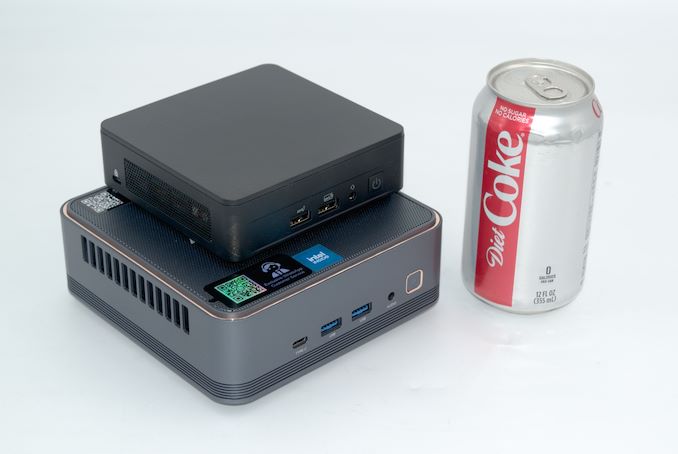
Arena Canyon NUC (T) and the ACEMAGIC F2A 125H (B)
The ACEMAGIC F2A 125H stands out from the crowd for its effective use of increased size for higher performance. It is also one of the first SFF PCs to integrate Wi-Fi 7 support (even the NUC14 series is reliant on Wi-Fi 6E for now). ACEMAGIC is currently running a $200 discount on the system with the price tag reduced to $569. At that price point, we believe it doesn't provide enough value due to the lack of Thunderbolt / USB4 support. The equivalent barebones NUC14RKU5 retails for $535, and it is equipped with two Thunderbolt 4 ports enabling additional flexibility and expansion options. Equipping that with SODIMMs, SSD, and an OS license is bound to drive up the cost, but the expansion possibilities may be worth it for a wide range of customers.
ACEMAGIC's F2A 125H could have been an easy system to recommend if a better choice of I/O ports were to complement its thermal design and board size decisions. As it stands currently, the system has some unique qualities and its thermal profile is excellent. Are those good enough to make it a better choice compared to the other MTL-H systems in the market? Only a careful consideration of the end-user's requirements can answer that question.


